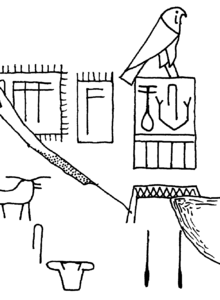Sneferka
| Sneferka | ||||||||||||||||||
|---|---|---|---|---|---|---|---|---|---|---|---|---|---|---|---|---|---|---|
| Neferseka, Sekanefer, Neferkaes | ||||||||||||||||||
 | ||||||||||||||||||
| Pharaoh | ||||||||||||||||||
| Reign | short, ca. 2900 BC (end of 1st Dynasty) | |||||||||||||||||
| Predecessor | unclear, possibly Qa'a or Horus Bird | |||||||||||||||||
| Successor | unclear, possibly Hotepsekhemwy or Horus Bird | |||||||||||||||||
| ||||||||||||||||||
Sneferka is the serekh-name of an early Egyptian king who may have ruled at the end of 1st dynasty. The exact length of his reign is unknown, but thought to have been very short and his chronological position is unclear.
Name sources
Sneferka´s serekh-name is the object of current investigations, because of the unusual typographical order of the hieroglyphic signs within the serekh. This led to several different readings: his name is read as Seneferka, Sneferka, Neferseka and Sekanefer.[3] The serekh-name "Sneferka" appears on several schist- and alabaster vessels. One was found in the mastaba of the high official Merka who served under king Qa'a; a second one in the underground galleries of the step pyramid of king Djoser (3rd dynasty) and the third was found in an anonymous mastaba, also at Sakkara. A fourth artifact with Sneferka's name is found in the private Georges-Michailidis-Collection but its authenticity is questioned by Archaeologists and Egyptologists, since its origin is unknown. Additionally, the inscription on the Michailidis-object is a serekh with no Horus-falcon, which is highly unusual for any Egyptian artifact of that time period.[4][5][6]
Identity
Beside Sneferka's serekh, the inscriptions mention several institutions and places already known thanks to finds dating to Qa'a's reign. They are called Qau-Netjeru ("Elevations of the gods") and Ah-Netjer ("Divine palace") and appear in several stone vessel inscriptions from Qa'a's tomb at Abydos. Egyptologists such as Peter Kaplony conclude that the inscriptions prove a chronological adjacency to king Qa'a or that the name "Sneferka" was an alternative name that Qa'a bore for a short time.
Two artifacts of different origins show the serekh of a king, whose name is highly disputed, for the hieroglyphic sign used to write the king's name is almost illegible. Since at least the depiction of a bird was recognised, the king in question is called "Horus Bird". Egyptologists such as Wolfgang Helck and Peter Kaplony believe that Sneferka and "Horus Bird" fought each other to gain the throne of Egypt. The struggles peaked in the plundering of the royal cemetery of Abydos, which was therefore abandoned. The struggle for the throne was possibly brought to an end by the founder of the 2nd dynasty, king Hotepsekhemwy. An evidence supporting this theory is the Horus name of Hotepsekhemwy which means "The two powers are reconciled", and could relate to a re-unification of the Egyptian realm after a period of discord.[7][8][9]
In contrast, Egyptologist Kim Ryholt believes that Sneferka ruled during the midst of 2nd dynasty and was to be identified with Neferkara I, attested in Ramesside sources. He points to the circumstance that Ramesside scribes often added the symbol of the sun to the names of early dynastic kings, ignoring the fact that the sun was not yet an object of divine adoration at that early time. To support his view, Ryholt points to cartouche names such as Neferkara II and Nebkara I, which represent early kings and contradictorily have a sun-symbol in their names.[10] Egyptologist Aidan Dodson thinks alike and points to the fact, that nearly all serekhs of Sneferka are made "on erasures", thus leading to the conclusion that Sneferka usurped Qa'a's vessels. This behavior was typical for kings that ruled somewhat later than the original owner of the re-used artefacts and who ruled for a very short time only.[11]
External links
References
- ↑ Pierre Lacau & Jean-Philippe Lauer: La Pyramide à Degrés IV. – Inscriptions gravées sur les Vases: Fouilles à Saqqarah., Service des antiquités de l’Égypte, Cairo 1936
- ↑ Pierre Lacau & Jean-Philippe Lauer: La Pyramide à Degrés IV. – Inscriptions gravées sur les Vases: Fouilles à Saqqarah., Service des antiquités de l’Égypte, Cairo 1936
- ↑ I.E.S. Edwards: The Cambridge ancient history, Volume 1-3. Cambridge University Press, 1970, ISBN 0-521-07791-5, page 29.
- ↑ Walter Brian Emery: Great tombs of the First Dynasty: Excavations at Saqqara, vol. 3. Egypt exploration society, London/Cairo 1958. page 38.
- ↑ Pierre Lacau & Jan-Phillip Lauer: La Pyramide a Degrees IV. - Inscriptions Gravees sur les Vases: Fouilles à Saqqarah. Service des antiquités de l'Égypte, Kairo 1936, page 15–17.
- ↑ Toby Wilkinson: Early Dynastic Egypt. Routledge, London 1999, ISBN 0-415-18633-1, page 69.
- ↑ Peter Kaplony: „Er ist ein Liebling der Frauen“ – Ein „neuer“ König und eine neue Theorie zu den Kronprinzen sowie zu den Staatsgöttinnen (Kronengöttinnen) der 1./2. Dynastie. In: Manfred Bietak: Ägypten und Levante. Verlag der Österreichischen Akademie der Wissenschaften, Wien 2006 ISBN 978-3-7001-6668-9; page 126–127.
- ↑ Dietrich Wildung: Die Rolle ägyptischer Könige im Bewußtsein ihrer Nachwelt. page 36–41.
- ↑ Wolfgang Helck: Untersuchungen zur Thinitenzeit. (Ägyptologische Abhandlungen, Vol. 45). Harrassowitz, Wiesbaden 1987, ISBN 3-447-02677-4; page 117
- ↑ Kim Ryholt, in: Journal of Egyptian History; vol.1. BRILL, Leiden 2008, ISSN 1874-1657, page 159–173.
- ↑ Aidan Dodson: The Mysterious Second Dynasty In: KMT - A Modern Journal of Ancient Egypt Nr.7. Kmt Communications, San Francisco 1996, ISSN 1053-0827, S. 19-31.
| Preceded by Qa'a |
Pharaoh of Egypt | Succeeded by Horus Bird |
